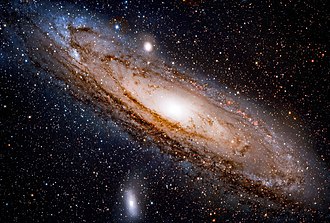Andromeda Galaxy

The Andromeda Galaxy (IPA: /ænˈdrɒmɪdə/), also known as Messier 31, M31, or NGC 224 and originally the Andromeda Nebula (see below), is a barred spiral galaxy approximately 2.5 million light-years (770 kiloparsecs) from Earth and the nearest major galaxy to the Milky Way.[6] The galaxy’s name stems from the area of Earth’s sky in which it appears, the constellation of Andromeda, which itself is named after the Ethiopian (or Phoenician) princess who was the wife of Perseus in Greek mythology.
The virial mass of the Andromeda Galaxy is of the same order of magnitude as that of the Milky Way, at 1 trillion solar masses (2.0×1042 kilograms). The mass of either galaxy is difficult to estimate with any accuracy, but it was long thought that the Andromeda Galaxy is more massive than the Milky Way by a margin of some 25% to 50%. This has been called into question by a 2018 study that cited a lower estimate on the mass of the Andromeda Galaxy,[10] combined with preliminary reports on a 2019 study estimating a higher mass of the Milky Way.[11][12] The Andromeda Galaxy has a diameter of about 220,000 ly (67 kpc), making it the largest member of the Local Group in terms of extension.
The number of stars contained in the Andromeda Galaxy is estimated at one trillion (1×1012), or roughly twice the number estimated for the Milky Way.[13][needs update]
The Milky Way and Andromeda galaxies are expected to collide in around 4-5 billion years,[14] merging to form a giant elliptical galaxy[15] or a large lenticular galaxy.[16] With an apparent magnitude of 3.4, the Andromeda Galaxy is among the brightest of the Messier objects,[17] making it visible to the naked eye from Earth on moonless nights,[18] even when viewed from areas with moderate light pollution.
Around the year 964, the Persian astronomer Abd al-Rahman al-Sufi was the first to describe the Andromeda Galaxy. He referred to it in his Book of Fixed Stars as a “nebulous smear”.[19]
Star charts of that period labeled it as the Little Cloud.[20] In 1612, the German astronomer Simon Marius gave an early description of the Andromeda Galaxy based on telescopic observations.[21] Pierre Louis Maupertuis conjectured in 1745 that the blurry spot was an island universe.[22] In 1764, Charles Messier cataloged Andromeda as object M31 and incorrectly credited Marius as the discoverer despite it being visible to the naked eye. In 1785, the astronomer William Herschel noted a faint reddish hue in the core region of Andromeda. He believed Andromeda to be the nearest of all the “great nebulae”, and based on the color and magnitude of the nebula, he incorrectly guessed that it was no more than 2,000 times the distance of Sirius, or roughly 18,000 ly (5.5 kpc).[23] In 1850, William Parsons, 3rd Earl of Rosse made the first drawing of Andromeda’s spiral structure.
